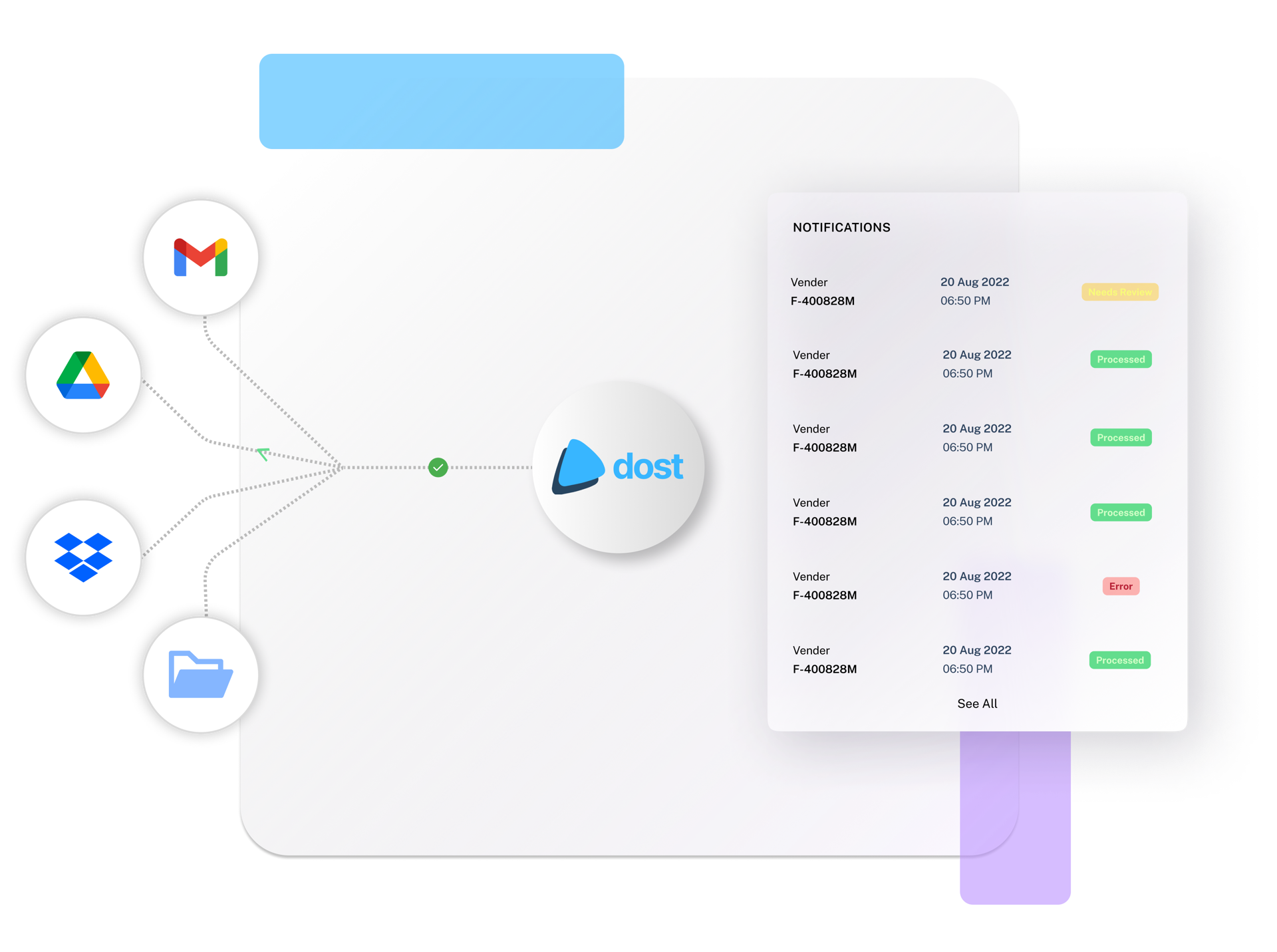OCR - Recognition Character Optician
Discover how the combination of OCR and artificial intelligence is revolutionizing the way we process and manage documents. Discover how to automate invoice management to optimize your workflow with Dost
✔️ 100% automated invoice management
✔️ Reduce your administrative costs by 80%
✔️ Goodbye human errors, maximum precision with AI
✔️ Complete visibility and control from a single platform
Request more information👇🏼
Introduction to OCR and its evolution
💡 What is OCR?
Opticial Character Recognition, commonly known as OCR (Optical Character Recognition), is a technology that has transformed the way we interact with physical and digital documents. OCR is a tool that interprets physical text or images and converts them into digital data that can be processed on your computer.
Imagine the typical scenario in an office: mountains of printed documents, invoices, contracts... waiting to be digitized for storage or processing. This is where the OCR comes into play. OCR allows you to scan these physical documents and automatically extract the text contained in them, thus eliminating the need to manually transcribe each word.
📈 Evolution of OCR over time
First steps
The concept of character recognition dates back to the 1950s and 1960s, when people began exploring ways to teach computers to interpret printed text. These early systems were rudimentary and based on predefined rules.
Digitalization era
In the 1970s and 1980s, OCR began to gain traction as a tool for converting printed documents into digital format. OCR systems of this era were capable of recognizing a very limited variety of fonts and text styles.
Advances in 1990
1990 marked a turning point in the development of OCR, with significant improvements in recognition accuracy and speed. More sophisticated algorithms based on neural networks and machine learning were introduced.
Artificial intelligence
With the arrival of Artificial intelligence techniques in recent decades, OCR has experienced a revolution. Now, software like Dost is capable of enhancing the work of OCR and achieving levels of precision and speed never seen before.
🤖 Importance of OCR in the digital age
OCR presents a series of very important benefits and advantages for your business, and especially for your financial and accounting departments. Here we leave you some 👇🏼
How OCR works with Artificial Intelligence
El OCR con inteligencia artificial (IA) representa la evolución más reciente y emocionante de esta tecnología, llevándola a nuevos niveles de precisión y versatilidad. A diferencia de los sistemas tradicionales de OCR, que dependían en gran medida de reglas predefinidas y algoritmos de reconocimiento de patrones, el OCR con IA utiliza modelos de aprendizaje automático para entender y procesar texto de manera más parecida a como lo hace el cerebro humano.
Advantages of combining OCR and AI
The combination of Optical Character Recognition (OCR) and Artificial Intelligence (AI) is a powerful synergy that offers a number of significant advantages in document processing and management. 👇🏼
🎯 Precision improved
AI enables OCR to recognize and understand text patterns with greater accuracy. By using machine learning models, OCR with AI can identify and correct errors more efficiently, guaranteeing the accuracy and reliability of the results.
🧾 Document adaptability
AI allows OCR to dynamically adapt and adjust to different document types, fonts, and text styles. This means that AI OCR is capable of recognizing and processing a wide variety of documents, from invoices and delivery notes to purchase orders and tickets.
🔀 Task automation
The combination of OCR and AI makes it possible to automate tasks related to document management. From data extraction and document classification to reporting and decision making, OCR with AI can streamline and simplify complex processes.
📊 Advanced data analysis
AI also opens up opportunities in data analysis and information extraction. By combining OCR with AI, hidden patterns and trends can be identified in large data sets, providing valuable insights for business decision-making.
Practical applications of OCR online
✔︎ Digitization of documents and files
Digitizing documents and files is one of the most practical and beneficial applications of online OCR in the digital age. This technology allows us to convert physical documents into accessible digital formats, which not only simplifies their storage and management, but also opens up new possibilities in terms of search, collaboration and information security.
→ See more about Document Capture
✔︎ Automatic data extraction from forms
The automatic extraction of data from forms is one of the most valuable and efficient applications of online OCR in the business and administrative field. this technology allows us to quickly digitize and process information contained in physical or digital forms, eliminating the need for manual data entry and reducing human errors.
→ See more about Data Extraction
✔︎ Facilitation of searches and analysis of information
Online OCR not only simplifies the conversion of printed documents into digital format, but also greatly facilitates the search and analysis of the information contained in these documents. This search and analysis capability is critical in the digital age, where rapid retrieval and understanding of information is essential for informed decision making and business success.
→ See more about Information Analysis
Automation of Invoice Management with OCR
Invoice management is a crucial part of any business, but it can also be a tedious and error-prone task when done manually. This where automating invoice management with OCR (Optical Character Recognition) plays a fundamental role, revolutionizing the way companies manage and process their invoices.
Importance of automated invoice management
Automated invoice management is crucial to optimizing a company's financial processes. Eliminates the need for repetitive manual tasks such as data entry, thereby reducing errors and increasing efficiency. Additionally, it allows for more accurate tracking of invoices, ensuring they are paid on time and avoiding potential penalties for late payments. Automation also makes it easier to comply with tax and accounting regulations, ensuring that all records are up-to-date and accurate.
How OCR with AI optimizes the billing process
AI OCR streamlines the billing process by eliminating the need for manual data entry. Using advanced character recognition and machine learning algorithms, OCR can automatically scan and extract key information from invoices, such as dates, quantities, and invoice numbers. This significantly reduces the time required to process invoices and minimizes errors associated with manual data entry. Additionally, AI OCR can learn and adapt over time, improving its accuracy and efficiency with each invoice processed.
Benefits of invoice automation with OCR
Invoice automation with OC reduces operational costs by eliminating the need for manual labor to process invoices, allowing you to allocate resources to more strategic tasks and focus on business growth. Additionally, automation improves accuracy and consistency in invoice processing, reducing the risk of errors and discrepancies in financial records. Improve decision making with more accurate and timely information. Additionally, invoice automation with OCR improves visibility and control over the billing process.
Subvencionado por el CDTI
Soluciones
Iniciar sesión


